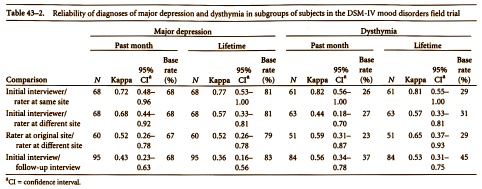Just another small point about the Field Trial editorial, this part of the editorial didn’t make any sense to me:
The Initial Field Trials of DSM-5: New Blooms and Old Thorns
by Robert Freedman, David A. Lewis, Robert Michels, Daniel S. Pine, Susan K. Schultz, Carol A. Tamminga, Glen O. Gabbard, Susan Shur-Fen Gau, Daniel C. Javitt, Maria A. Oquendo, Patrick E. Shrout, Eduard Vieta, and Joel Yager
American Journal of Psychiatry 2013 170:1-5.
The questionable reliability of major depressive disorder, unchanged from DSM-IV, is obviously a problem. Major depressive disorder has always been problematic because its criteria encompass a wide range of illness, from gravely disabled melancholic patients to many individuals in the general population who do not seek treatment. Although symptom severity on the Hamilton Depression Rating Scale distinguishes those patients who respond more specifically to pharmacotherapy, the DSM-IV criteria do not capture that distinction. A second problem not resolved by the DSM-IV criteria is the common co-occurrence of anxiety, which markedly diminishes the effects of antidepressant treatment. The DSM-5 work group decided not to change the criteria for major depressive disorder from DSM-IV and instead created other diagnoses for the mixture between anxiety and depression. However, these efforts did not improve the poor reliability of DSM-IV depression; “mixed anxiety and depression” has a kappa of 0…
The comment about the reliability [kappa] of major depressive disorder being "unchanged from DSM-IV" didn’t fit with my information. The DSM-5 Field Trials for MDD reported kappa = 0.25 with 95% CL [0.13-0.36]. I just happen to own a used copy of the DSM-IV Sourcebook Volume 4:

I bought it for the following paragraph alone. I wanted to see if the DSM-5 Standards had been redefined as Dr. Frances reported in his blog. This is what the DSM-IV Sourcebook said:

Dr. Frances spoke the truth. And this was the standard reportedly used by the DSM-5 Task Force:
DSM-5: How Reliable Is Reliable Enough?
by Helena Chmura Kraemer, David J. Kupfer, Diana E. Clarke, William E. Narrow, and Darrel A. Regier
American Journal of Psychiatry 2012 169:13-15.
… to see a κI for a DSM-5 diagnosis above 0.8 would be almost miraculous; to see κI between 0.6 and 0.8 would be cause for celebration. A realistic goal is κI between 0.4 and 0.6, while κI between 0.2 and 0.4 would be acceptable.
So, I opened the book again to the chapter on the DSM-IV Field Trials for major depressive disorder that showed a table with the multiple comparisons they did for reliability [kappa]:

I don’t see anything like a kappa = 0.25, no matter what they compared with what. So I have no clue what "unchanged from DSM-IV" means…
By the way, if anyone’s looking for a DSM-IV Sourcebook Volume 4, I’ve got one I’ll let go of for a song…
This is one of those sly maneuvers that bureaucrats love. What is unchanged is the main text of the MDD criteria in DSM-5 compared to DSM-IV. That’s what they are talking about, not the kappas. The ambiguity allows them to avoid the hard questions. But of course the definition of MDD is changed with the removal of the bereavement exclusion. Plus, the positive connotation associated with the descriptor unchanged distracts attention from the fact that they needed to change MDD along the lines you mentioned – where is melancholia and where is vascular depression? There is a better evidence base for these than for some of the changes they did adopt.
Excellent point! Either I’m brain dead and embarrassed at the misreading or incredulous and tired of being mad that the unchanged MDD criteria [then again, maybe I just wanted to get full use from my pristine DSM-IV Sourcebook Volume 4] (still available)…
http://www.nndc.org/
“Welcome! The National Network of Depression Centers (NNDC) is a non-profit 501(c)(3) network of 21 leading clinical and academic Centers of Excellence in the U.S working to transform the field of depressive illnesses and related mood disorders.”
“About Us
Our History
The history of the National Network of Depression Centers cannot be completely told without first retelling an earlier history; that of another class of chronic, widespread diseases: cancer.”
” Adapting the cancer model
In 2007, leaders in the field from the top academic medical centers in the country gathered to explore ways to apply the lessons learned in the war on cancer to depression and bipolar illnesses and related mood disorders. A key first step was the establishment of Centers of Excellence. These Centers of Excellence would lead a coordinated effort to generate new knowledge and educate a new generation of specialists in healthcare and across the broader community, eventually reaching all Americans with a message of understanding and hope, to transform the depression landscape.
The need to facilitate collaboration between these centers was the impetus to form the National Network of Depression Centers (NNDC), effecting meaningful transformation in the field by bringing together the leading specialists from across the country to develop and implement best practices for diagnosis, treatment, outreach and advocacy. Only by working together can we develop the infrastructure needed for large-scale clinical trials, data registries, standardized assessment, stigma reduction, and delivery of care to all Americans.
In 2008, a charter was adopted to form the National Network of Depression Centers (NNDC), a 501 (c)(3) nonprofit organization with 16 founding member institutions. Priorities were identified, and work began in our committees and task groups. Membership in the NNDC has since expanded to 21 esteemed institutions, and continued growth is anticipated.”
“The Power of a Network
Only the large-scale, nationwide efforts of a coordinated network can make our vision a reality. The NNDC provides the platform for bringing the best minds together, regardless of their location, to achieve these broad objectives:
The standardization of protocols for screening, diagnosis, and treatment, including establishing evidence-based practices for self-management of the symptoms of these diseases
Large-scale research to move our understanding forward, encompassing basic or laboratory research, clinical studies, and translational research to rapidly move findings from the research lab to the clinical setting.
Improved access to care for all populations through a “hub and spoke” system, anchored by Centers of Excellence at major academic medical centers that disseminate evidence-based information and expertise to practitioners in local communities, eventually realizing the vision of a future free of the burden of depressive illnesses.
Education and outreach on a national level to mobilize policy, advocate for public and private support, and supplant stigma with understanding.”
Don’t look for NNDC to rock any boats. Where were they during the debates over mood disorders in DSM-5?